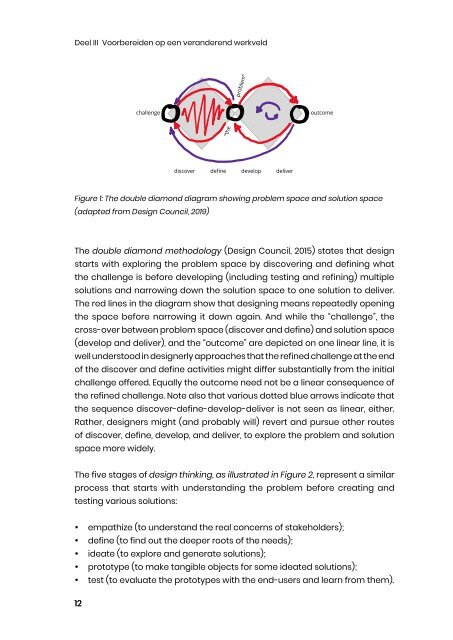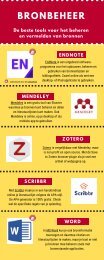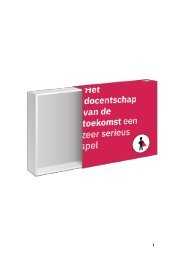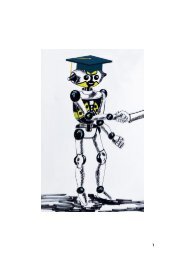13. Digital transformations and their design – renewal of the socio-technical approach
You also want an ePaper? Increase the reach of your titles
YUMPU automatically turns print PDFs into web optimized ePapers that Google loves.
Deel III Voorbereiden op een ver<strong>and</strong>erend werkveld<br />
problem”<br />
challenge<br />
outcome<br />
“<strong>the</strong><br />
discover define develop deliver<br />
Figure 1: The double diamond diagram showing problem space <strong>and</strong> solution space<br />
(adapted from Design Council, 2019)<br />
The double diamond methodology (Design Council, 2015) states that <strong>design</strong><br />
starts with exploring <strong>the</strong> problem space by discovering <strong>and</strong> defining what<br />
<strong>the</strong> challenge is before developing (including testing <strong>and</strong> refining) multiple<br />
solutions <strong>and</strong> narrowing down <strong>the</strong> solution space to one solution to deliver.<br />
The red lines in <strong>the</strong> diagram show that <strong>design</strong>ing means repeatedly opening<br />
<strong>the</strong> space before narrowing it down again. And while <strong>the</strong> “challenge”, <strong>the</strong><br />
cross-over between problem space (discover <strong>and</strong> define) <strong>and</strong> solution space<br />
(develop <strong>and</strong> deliver), <strong>and</strong> <strong>the</strong> “outcome” are depicted on one linear line, it is<br />
well understood in <strong>design</strong>erly <strong>approach</strong>es that <strong>the</strong> refined challenge at <strong>the</strong> end<br />
<strong>of</strong> <strong>the</strong> discover <strong>and</strong> define activities might differ substantially from <strong>the</strong> initial<br />
challenge <strong>of</strong>fered. Equally <strong>the</strong> outcome need not be a linear consequence <strong>of</strong><br />
<strong>the</strong> refined challenge. Note also that various dotted blue arrows indicate that<br />
<strong>the</strong> sequence discover-define-develop-deliver is not seen as linear, ei<strong>the</strong>r.<br />
Ra<strong>the</strong>r, <strong>design</strong>ers might (<strong>and</strong> probably will) revert <strong>and</strong> pursue o<strong>the</strong>r routes<br />
<strong>of</strong> discover, define, develop, <strong>and</strong> deliver, to explore <strong>the</strong> problem <strong>and</strong> solution<br />
space more widely.<br />
The five stages <strong>of</strong> <strong>design</strong> thinking, as illustrated in Figure 2, represent a similar<br />
process that starts with underst<strong>and</strong>ing <strong>the</strong> problem before creating <strong>and</strong><br />
testing various solutions:<br />
• empathize (to underst<strong>and</strong> <strong>the</strong> real concerns <strong>of</strong> stakeholders);<br />
• define (to find out <strong>the</strong> deeper roots <strong>of</strong> <strong>the</strong> needs);<br />
• ideate (to explore <strong>and</strong> generate solutions);<br />
• prototype (to make tangible objects for some ideated solutions);<br />
• test (to evaluate <strong>the</strong> prototypes with <strong>the</strong> end-users <strong>and</strong> learn from <strong>the</strong>m).<br />
12


















